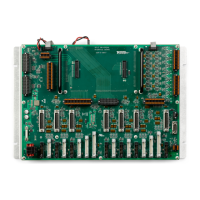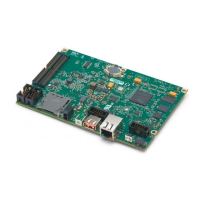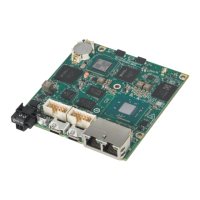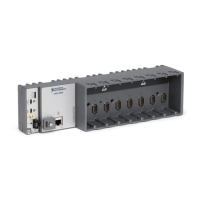1 Therm1 4 Therm0
2 Therm1_GND 5 Therm0_GND
3 CHASSIS GND 6 CHASSIS GND
Thermistor Reading
The two thermistor outputs are multiplexed into the GPIC scanned AI_7 with the help of one
LVTTL line. When the LVTTL line is 0, the Therm0 signal is connected to AI_7. When the
LVTTL line is 1, the Therm1 signal is connected to AI_7.
DIO29 AI_7 Input
0 Thermocouple 0 input (Therm0)
1 Thermocouple 1 input (Therm1)
The following formula describes how the thermistor value can be obtained from the scanned
AI voltage:
R
Tℎermistor
=
V
AI_7
5V − V
AI_7
× 10 k Ω
where
R
Thermistor
= Thermistor resistance.
V
AI_7
= Voltage reading at the GPIC scanned AI_7.
To obtain the temperature, the thermistor value must be converted into temperature units based
on the typical thermistor characteristics obtained from thermistor manufacturer.
Relative Humidity Sensor
For safety, a high voltage system should not be operated when condensation conditions are
present. The sbRIO-9687 interface board has a built-in environmental sensor that measures
temperature and relative humidity (RH) on the board.
Use the following formula to determine the RH on a different point of the cabinet:
RH
cabinet
= RH
board
× e
17.502 × T
board
240.97 + T
board
−
17.502 × T
cabinet
240.97 + T
cabinet
46 | ni.com | sbRIO-9687 User Manual

